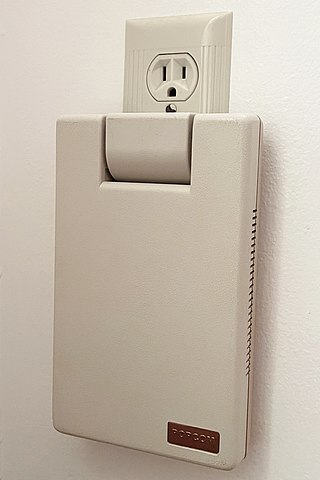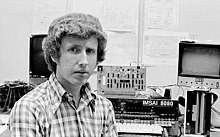
A bulletin board system (BBS), also called a computer bulletin board service (CBBS), was a computer server running software that allowed users to connect to the system using a terminal program. Once logged in, the user can perform functions such as uploading and downloading software and data, reading news and bulletins, and exchanging messages with other users through public message boards and sometimes via direct chatting. In the early 1980s, message networks such as FidoNet were developed to provide services such as NetMail, which is similar to internet-based email.

In telecommunications, an acoustic coupler is an interface device for coupling electrical signals by acoustical means—usually into and out of a telephone.
The Hayes command set is a specific command language originally developed by Dale Heatherington and Dennis Hayes for the Hayes Smartmodem 300 baud modem in 1981.
U.S. Robotics Corporation, often called USR, is a company that produces USRobotics computer modems and related products. Its initial marketing was aimed at bulletin board systems, where its high-speed HST protocol made FidoNet transfers much faster, and thus less costly. During the 1990s it became a major consumer brand with its Sportster line. The company had a reputation for high quality and support for the latest communications standards as they emerged, notably in its V.Everything line, released in 1996.
Tangerine Computer Systems was a British microcomputer company founded in 1979 by Dr. Paul Johnson, Mark Rainer and Nigel Penton Tilbury in St. Ives, Cambridgeshire.
Dennis C. Hayes is the inventor of PC modem and founder of Hayes Microcomputer Products, a manufacturer of modems mostly known for introducing the Hayes AT command set, which has subsequently been used in most modems produced to this day.
Hayes Microcomputer Products was a U.S.-based manufacturer of modems. The company is known for the Smartmodem, which introduced a control language for operating the functions of the modem via the serial interface, in contrast to manual operation with front-panel switches. This smart modem approach dramatically simplified and automated operation. Today almost all modems use a variant of the Hayes command set.

Novation, Inc., is an early modem manufacturer whose CAT series were popular in the early home computer market in the late 1970s and early 1980s, notably on the Apple II. The Hayes Smartmodem 300, introduced in 1981, helped kill off Novation and many other early modem companies over the next few years.
Microcom, Inc., was a major modem vendor during the 1980s, although never as popular as the "big three", Hayes, U.S. Robotics (USR) and Telebit. Nevertheless, Microcom holds an important place in modem history for introducing the MNP error-correction and compression protocols, which were widely used under license by most modem manufacturers in the 1990s. The company went public in 1987. Compaq purchased publicly outstanding shares of the company in 1997.
The Time Independent Escape Sequence, or TIES, is a modem protocol standard invented to avoid a patent held by Hayes Microcomputer Products. TIES is an escape sequence that switches the modem from "data mode" to "command mode", allowing instructions to be sent to the modem to control it while still connected to the remote modem.

NO CARRIER (capitalized) is a text message transmitted from a modem to its attached device, indicating the modem is not connected to a remote system.
The following outline is provided as an overview of and topical guide to automation:
A voice modem is an analog telephone data modem with a built-in capability of transmitting and receiving voice recordings over the phone line. Voice modems are used for telephony and answering machine applications. Similar to the Hayes command set used for data modems, in which the host PC commands the modem via a series of commands known as AT commands, there exists a well-defined set of common voice AT commands that are somewhat consistent throughout the industry.

A modulator-demodulator or modem is a computer hardware device that converts data from a digital format into a format suitable for an analog transmission medium such as telephone or radio. A modem transmits data by modulating one or more carrier wave signals to encode digital information, while the receiver demodulates the signal to recreate the original digital information. The goal is to produce a signal that can be transmitted easily and decoded reliably. Modems can be used with almost any means of transmitting analog signals, from light-emitting diodes to radio.
In re Hayes Microcomputer Products, Inc. Patent Litig., 982 F.2d 1527 was a case decided in 1992 by the United States Court of Appeals for the Federal Circuit, the successor of the United States Court of Customs and Patent Appeals. It concerned, among other things, whether or not the software on a patented device needed to be disclosed in a patent application.
In telecommunications, RS-366, later known as EIA-366, defines a standard for serial communications between computers and an auto dialer, which is used to dial telephones. It was intended to be used to automate the operation of modems. The standard uses the same DB25 connectors and electrical signalling standards of the well-known RS-232 standard, which RS-366 was designed to support. The CCITT had a matching standard, V.25.
Penril DataComm Networks, Inc. was a computer telecommunications hardware company that made some acquisitions and was eventually split into two parts: one was acquired by Bay Networks and the other was a newly formed company named Access Beyond. The focus of both company's products was end-to-end data transfer. By the mid-1990s, with the popularization of the internet, this was no longer of wide interest.

Popcom was a line of modems marketed by the Prentice Corporation of Sunnyvale, California, introduced in 1984. The line comprised six models—X100, X150, C100, C150, C200, C250—the C models being internal modems meant to plug into a free ISA expansion slot of a PC compatible, while the X models were compact external units intended to be plugged into a wall indefinitely and connected to the computer via a serial cable. The X100 and X150 were noted by the press for their very small physical footprint among its contemporaries in the market.
Practical Peripherals, Inc., was a private American computer peripheral manufacturer active from 1981 to 1999 and based in Los Angeles County. Founded by Michael Seedman, the company specialized in telecommunications products, primarily modems, for personal computers. Seedman led the company from its inception in 1981 until 1993, after Practical Peripherals was sold to Hayes Microcomputer Products.

Boca Research, Inc., later Inprimis, Inc., was an American computer company based in Boca Raton, Florida, and active between 1985 and 2002. The company manufactured a variety of expansion cards for the IBM PC and compatible systems, including memory cards, networking cards, sound cards, and graphics cards. Once a major player in the computer networking market, being the fourth-largest manufacturer of modems in 1996, Boca Research abandoned the PC hardware market entirely amid falling market share and manufactured set-top boxes in the last years of its existence.







